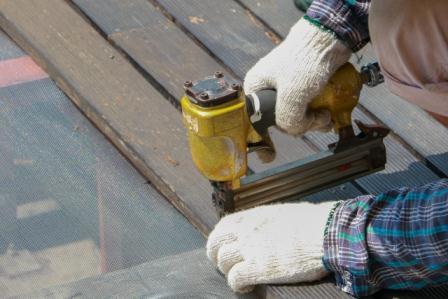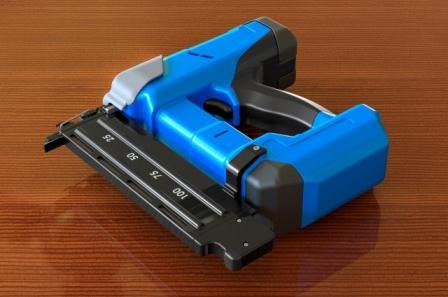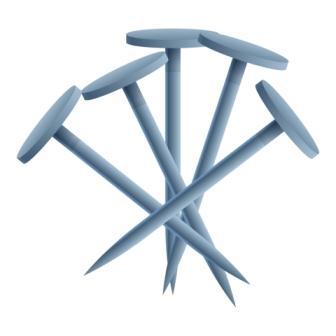Pin Nailer vs Brad Nailer: What to use?
Depending on the project you may need multiple types of nailers and both pin nailers and brad nailers are essential for a project. Both are necessary but you have to buy one first and buying a nailer can be quite an investment for many people.
For this reason, buying the right one according to your project is mandatory. Today we will discuss both pin nailer and brad nailer in detail so you can easily pick the right one for you without a hassle. We will discuss what they are, where to use them and how they vary from each other i.e Pin Nailer vs Brad Nailer.
Pin Nailers

As the name suggests a pin nailer fire pins and they are the most delicate and smallest one in the finish nailers family. Pin nailers use 23-gauge nails which are the smallest in diameter and mainly the pins are headless. They are specific in use and provide almost zero holding power and often adhesives are used in conjunction with the nails.
Read More: Pin Nailer vs Finish Nail Gun: Things you need to Know
Brad Nailers
Brad nailers use 18-Gauge nails which have a specific flat nail head and loved by the woodworkers for their versatility. A brad nailer can be used in different stages of the project and due to the specific design of the nails they provide greater holding power with respect to their gauge.

Read More: Crown Stapler vs Brad Nailer: Guide to Choose the Best for Your Project
Factors to separate Pin Nailer vs Brad Nailer
Now we will discuss the differences between them on key factors
Types of Nails
As stated above pin nailers use 23-Gauge nails which are the smallest in diameter and most of the pin nailers use 1inch nails. There are some pin nailers that can shoot 2-inch long nails too. The main characteristics of the pins shoot by a pin nailer is that they have no heads. This characteristic of the pins makes them most suitable for final finishing works.

A brad nailer uses 18-gauge pins and the nails come 3/8-inch to 2-inch in length. Although they are 18-gauge nails, their specific head designs provide strength equal to 15/16-gauge nails.
Read More: Different Nail Size For Framing
Use
A pin nailer is used for specific purposes which include attaching crown moulding, thin veneers, finishing work in carpentry, fixing cabinetry, trimming delicate pieces, making fragile wooden toys etc. pins used by the pin nailer have the minimum gauge nails and it is suitable for any kind of delicate work without ripping the pieces apart. It is also used to hold carpentry until the adhesive dries off.
A brad nailer can be used almost for any woodworking or finishing purposes such as attaching baseboards, crown moulding, trim work, woodwork, window and door casing etc. Its adequate holding capacity allows it to hold moderate thick pieces until the adhesive dries off or allows perfect drilling by holding them.
Strength
The strength provided by a brad nailer passes a pin nailer by some distance. Due to the lack of pinheads, the nails of the pin nailer provide almost zero holding power.
On the other hand, the brad nailer nails provide adequate strength of 15/16-gauge nails although they are 18-gauge nails. The 23-gauge nails of a pin nailer need adhesive in most cases to hold the pieces together.
Necessity of putty
Proving putty in the holes created by a nailer can be a tedious job and it is necessary to have the perfect finished look. Brad nailers create larger holes than pin nailers and they need putty to cover them. Nails of the pin nailers have no head and the holes created by them are minimum in size. A simple application of paint or stain is enough for them. But in the case of the brad nailer proving putty is a must.
Versatility
A brad nailer is much more versatile than a pin nailer. The nails of brad nailers come in different lengths and they provide adequate strength to do different types of work. The use of a pin nailer is bound by specific works only.
Power
Both the pin nailer and brad nailer are powerful nail guns and they can drive up the pins into the woods easily. Depending on the types and model the power of a nail gun vary from each other but generally a brad nailer is a little bit powerful than a pin nailer.
Let’s talk about the pros and cons of both the nailers in short now to have the final verdict.
Comparison of Brad Nailer vs Pin Nailer based on their Pros and Cons
Pros of pin nailer
- Minimum size if the nails make sure that it will not split your delicate and thin pieces.
- It is the best nailer to trim pieces or veneers.
- Nails do not leave any visible nail holes.
- Perfect for DIY projects such as making wooden toys or Crown moulding.
- Less costly than a brad nailer.
Cons of Pin nailer
- It is not versatile at all as it is used for specific purposes.
- Provide little holding power.
- Cannot be used for thick wood pieces.
Pros of Bard nailer
- Can be used for base boarding.
- Provide more holding power than a pin nailer.
- Its versatility allows it to be used for various applications.
- A necessary tool to have for almost any house renovation or woodworking.
Cons of Brad Nailer
- Not suitable for delicate works. Can easily split the pieces.
- The nails leave visible nail holes. Proving putty is necessary.
- Costlier than a pin nailer.
Verdict
A good finish nailer is a must to have the perfect finishing touch and they are valued accordingly both by professionals and DIYers. Everyone wants to attain the perfect finished look and a good nailer is like a best friend to anyone who wants this.
Finishing work can be tedious and the main idea for using a nail gun to make the work stress free and easy. So the final verdict is choosing the right nail gun according to your work type. Try to find out which nailer is a must for your work then choose accordingly.
Choose the pin nailer if you are working with delicate trims or you simply don’t like using putty in the nail holes after work. But choose the brad nailer if you have the versatility and holding power provided by it. We will finish by saying that it is necessary to know your task before you choose the nailer.
